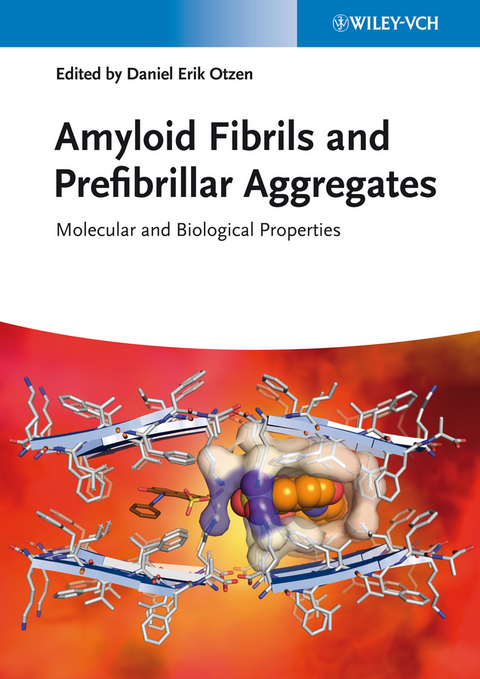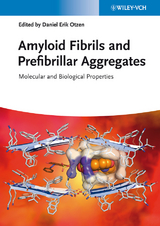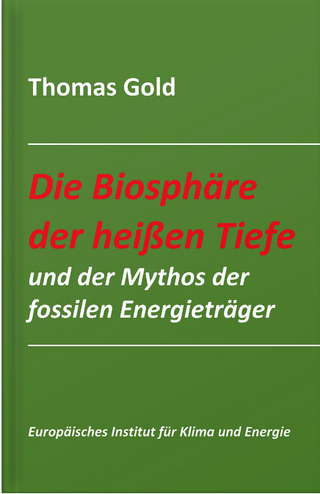Amyloid Fibrils and Prefibrillar Aggregates
Wiley-VCH (Verlag)
978-3-527-33200-7 (ISBN)
- Titel ist leider vergriffen;
keine Neuauflage - Artikel merken
Summing up almost a decade of biomedical research, this topical and eagerly awaited handbook is the first reference on the topic to incorporate recent breakthroughs in amyloid research.The first part covers the structural biology of amyloid fibrils and pre-fibrillar assemblies, including a description of current models for amyloid formation. The second part looks at the diagnosis and biomedical study of amyloid in humans and in animal models, while the final section discusses pharmacological approaches to manipulating amyloid and also looks at its physiological roles in lower and higher organisms. For Biochemists, Molecular Biologists, Neurobiologists, Neurophysiologists and those working in the Pharmaceutical Industry.
Daniel Otzen is professor of nanobiotechnology at the Interdisciplinary Nanoscience Center (iNANO) at Aarhus University, Denmark. He obtained his PhD at Aarhus University in 1995 after studies at the lab of Sir Alan Fersht, University of Cambridge, using protein engineering to dissect the folding pathways of model proteins. He has also worked as a staff scientist at Novozymes A/S within the field of stability and folding of industrial enzymes. In 2000 he established his own research group. His interests include pathological and functional amyloid formation, the structures and properties of pre-fibrillar species, approaches to prevent aggregation and oligomer formation and also the folding and stability of membrane proteins. He is a member of the Danish Royal Society of Sciences and Letters.
PREFACE
THE AMYLOID PHENOMENON AND ITS SIGNIFICANCE
Introduction
The Nature of the Amyloid State of Proteins
The Structure and Properties of Amyloid Species
The Kinetics and Mechanism of Amyloid Formation
The Link between Amyloid Formation and Disease
Strategies for Therapeutic Intervention
Looking to the Future
Summary
AMYLOID STRUCTURES AT THE ATOMIC LEVEL: INSIGHTS FROM CRYSTALLOGRAPHY
Atomic Structures of Segments of Amyloid-Forming Proteins
Stability of Amyloid Fibers
Which Proteins Enter the Amyloid State?
Molecular Basis of Amyloid Polymorphism and Prion Strains
Atomic Structures of Steric Zippers Suggest Models for Amyloid Fibers of Parent Proteins
Atomic Structures of Steric Zippers Offer Approaches for Chemical Interventions against Amyloid Formation
Summary
WHAT DOES SOLID-STATE NMR TELL US ABOUT AMYLOID STRUCTURES?
Introduction
Principles of Solid-State NMR Spectroscopy and Experiments for Structural Constraints
Amyloid Fibrils Investigated by Solid-State NMR Spectroscopy
Summary
FROM MOLECULAR TO SUPRAMOLECULAR AMYLOID STRUCTURES: CONTRIBUTIONS FROM FIBER DIFFRACTION AND ELECTRON MICROSCOPY
Introduction
History
Methodology
Recent Advances in Amyloid Structure Determination
Summary
STRUCTURES OF AGGREGATING SPECIES BY SMALL-ANGLE X-RAY SCATTERING
Introduction
Theoretical and Experimental Aspects
Data Analysis and Modeling Methods
Studying Protein Aggregation and Fibrillation Using SAXS
General Strategies for Modeling SAXS Data from Protein Complexes
Summary and Final Remarks
STRUCTURAL AND COMPOSITIONAL INFORMATION ABOUT PRE-AMYLOID OLIGOMERS
General Introduction
Biophysical Techniques to Study Amyloid Oligomers
The Structure and Composition of Amyloid Oligomers
Concluding Remarks
THE OLIGOMER SPECIES: MECHANISTICS AND BIOCHEMISTRY
Introduction
The Structure - Toxicity Relation of Early Amyloids
The Oligomer - Membrane Complex
Biochemical Modifications Underlying Amyloid Toxicity
Summary
PATHWAYS OF AMYLOID FORMATION
Introduction
Nomenclature of the Various Conformational States
Graphical Representations of the Mechanisms Leading to Amyloid
Pathways of Amyloid Fibril Formation
Nucleation Growth versus Nucleated Conformational Conversion
Summary
SEQUENCE-BASED PREDICTION OF PROTEIN BEHAVIOR
Introduction
The Strategy of the Zyggregator Predictions
Aggregation Under Other Conditions
Prediction of the Cellular Toxicity of Protein Aggregates
Relationship to Other Methods of Predicting Protein Aggregation Propensities
Competition between Folding and Aggregation of Proteins
Prediction of Protein Solubility from the Competition between Folding and Aggregation
Sequence-Based Prediction of Protein Interactions with Molecular Chaperones
Summary
THE KINETICS AND MECHANISMS OF AMYLOID FORMATION
Introduction
Classical Theory of Nucleated Polymerization
The Theory of Filamentous Growth with Secondary Pathways
Self-Consistent Solutions for the Complete Reaction Time Course
Summary
FLUORESCENCE SPECTROSCOPY AS A TOOL TO CHARACTERIZE AMYLOID OLIGOMERS AND FIBRILS
Introduction
Fluorescence Spectroscopy for Studies of Amyloid Reactions In vitro
Cysteine-Reactive Fluorescent Probes
Amyloidotropic Probes for Amyloid Fibrils and Oligomeric States
Luminescent Conjugated Poly and Oligothiophenes LCPs and LCOs
Summary
ANIMAL MODELS OF AMYLOID DISEASES
Introduction
Some Big Questions Regarding Amyloid Diseases and Some Answers from Animal Models
Identifying the Toxic Species in the Systemic Amyloidoses
Identifying the Toxic Species in Alzheimer's Disease
Infectious Protein Misfolding
Conclusions
THE ROLE OF AB IN ALZHEIMER'S DISEASE
History of Amyloidosis
Biochemistry of Aß
Amyloid Fibrils
The Soluble Oligomer Theory of AD
Other Factors Involved in Amyloid Plaque Formation in AD
Metal Ions in AD
Other Potential Aß Interactions
Other Neurodegenerative Diseases
Conclusion
EXPERIMENTAL APPROACHES TO INDUCING AMYLOID AGGREGATES
The Need for Reproducible Fibrillation Assays
Setting Up an Assay to Monitor Fibrillation
Conditions That Promote Protein Aggregation
Processing and Batch Differences
Toward High-Throughput Assays
Summary
FIBRILLAR POLYMORPHISM
Detection of Fibrillar Polymorphism
The Structural Definition of Fibril Polymorphism
The Two Classes of Fibril Polymorphism
How Does Fibrillar Polymorphism Arise?
The Interconversion of Fibril Polymorphs
The Biological Implications of Fibril Polymorphism
Summary
INHIBITORS OF AMYLOID AND OLIGOMER FORMATION
Introduction: Amyloidoses versus Neurodegenerative Diseases
Summary
DEVELOPMENT OF THERAPEUTIC STRATEGIES FOR THE TRANSTHYRETIN AMYLOIDOSES
Introduction to Transthyretin Structure and Function
Introduction to Amyloid Diseases in General
Mechanism of Transthyretin Amyloidogenesis
Kinetic Stabilization of the Transthyretin Tetramer through Small-Molecule Binding
Assessment of Diflunisal for Treatment of Transthyretin Amyloidosis
Tafamidis, the First Approved Drug for Treatment of a Transthyretin Amyloidosis
Summary
HORMONE AMYLOIDS IN SICKNESS AND IN HEALTH
Introduction
Constitutive vs. Regulated Secretory Pathways
Secretory Granules Contain Aggregated Cargo
Secretory Granule Aggregation by Functional Amyloid Formation
Hormone Amyloids in Disease: Diabetes Insipidus
Conclusions
FUNCTIONAL AMYLOIDS IN BACTERIA
Introduction
Functional Amyloids are Common in Nature
Identification and Characterization of Functional Amyloids
Functional Bacterial Amyloids Play Many Roles
Biogenesis and Regulation of Functional Bacterial Amyloids
Structural Composition of Functional Amyloids
Assembly Properties of Functional Amyloid In Vitro
Diversity and Distribution of Functional Amyloid Genes
Summary
STRUCTURAL PROPERTIES AND APPLICATIONS OF SELF-ASSEMBLING PEPTIDES
Introduction to Self-Assembling Peptides
The Principles of Self-Assembling Peptides
Self-Assembling Peptide Nanofibers
Diverse Applications of Self-Assembling Peptide Nanofibers Scaffolds
Summary
HARNESSING THE SELF-ASSEMBLING PROPERTIES OF PROTEINS IN SPIDER SILK AND LUNG SURFACTANT
Introduction
Amino Acid Sequences and Amyloid Formation
Spider Silk and How the Spiders Make It
Harnessing the Properties of Spider Silk and Its Constituent Proteins
Biosynthesis of an a-Helix from One of the Most ß-Prone Sequences Known
Anti-Amyloid Properties of the BRICHOS Domain
Summary
INDEX
| Erscheint lt. Verlag | 13.2.2013 |
|---|---|
| Verlagsort | Weinheim |
| Sprache | englisch |
| Maße | 170 x 240 mm |
| Gewicht | 1205 g |
| Themenwelt | Medizin / Pharmazie ► Medizinische Fachgebiete |
| Naturwissenschaften ► Biologie ► Biochemie | |
| Naturwissenschaften ► Chemie ► Organische Chemie | |
| Schlagworte | Amyloid • Biowissenschaften • Chemie • Chemistry • Fibrille • Fibrillin • Life Sciences • Medical Science • Medizin • Molecular Biology • Molekularbiologie • Protein • Proteine • Protein / Eiweiß • Protein Science • structural biology • Strukturbiologie |
| ISBN-10 | 3-527-33200-6 / 3527332006 |
| ISBN-13 | 978-3-527-33200-7 / 9783527332007 |
| Zustand | Neuware |
| Informationen gemäß Produktsicherheitsverordnung (GPSR) | |
| Haben Sie eine Frage zum Produkt? |
aus dem Bereich




